
|   |

|   |
Half a century innings - Kadamb going strong - Veejay Sai e-mail: kyaabaathain@gmail.com Photos: Vipul Sangoi December 29, 2015 Ahmedabad and classical dance don’t go back too long into history. Classical music, yes. But classical dance? Almost none! In fact it is a bit funny to know that a south Indian classical dance form established earlier before a northern one did, thanks to Mrinalini Sarabhai who married famous scientist Vikram Sarabhai and set up the Darpana Academy. This began cultivating dance-loving audiences slowly and steadily. It took a Maharashtrian with passion to set up Kathak in the city. Kumudini Jayakar, daughter of D.N. Jayakar, an engineer in Allahabad, won a government scholarship. As a part of her scholarship, she joined the Bharatiya Kala Kendra in Delhi and studied Kathak. She belonged to one of the earliest batches of students to train under the legendary Pt. Shambhu Maharaj. After four years of studying Kathak, she traveled extensively and partnered the great Ram Gopal on some of his most significant foreign tours. She returned to Ahmedabad and in 1965 established ‘Kadamb’. The sapling she planted is now a massive mammoth of a tree with blossoming flowers. This year Kadamb turned fifty! Fifty years in the life of any institution means a lot. Especially in a cultural institution dealing with classical arts, the challenges faced by the artistes are rather unusual. From raising funds to monitoring administration to teaching, the trauma of running them is endless. Difficulty increases when the institution is set up in a place where art and culture weren’t the priorities of the state. Guru Kumudini Lakhia (fondly addressed as Kumiben) did just that! To celebrate the occasion, a three-day festival ‘Suvarna Parva’ (Dec 11 - 13, 2015) was organized by Kadamb. Over a weekend a packed Tagore hall witnessed some excellent performances by Kadamb alumni from various generations. From the senior most and first student of Kadamb, to the latest junior kid, one saw Kathak in every flavour. Revisiting some of her successful and popular older choreographies, a whole host of students put together a grand festival. Through the course of three days, interacting with Kumiben revealed her unique perspective and approach to Kathak. She found a creative partner in the wonderful musician, the late Atul Desai. Through their affiliation, Kadamb was nurtured carefully. He provided music to most of her and later Kadamb’s work. 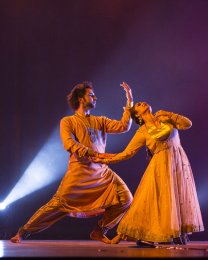 Sanjukta Sinha and Karan Pangali In ‘Yugal’, a piece Kumiben created in 1978, we saw dancers Sanjukta Sinha and Karan Pangali recreate the charm of sensuality. The idea of exploring shringara without dealing with the regular Hindu gods and goddesses, sometimes even getting away with the abhinaya and nritta, which are integral aspects to Kathak, must have surely been a challenge in the 70’s.  Prashant Shah & group In Prashant Shah’s choreography titled ‘And We Just Dance’, he explored why male dancers wanted to dance because they simply loved the job. Despite societal pressures that stereotyped and mocked their effort, male dancers have had a long and successful journey. Prashant and his group of male dancers put together an impressive, original and thought-provoking work. This is certainly a piece that must travel to more festivals and be seen. 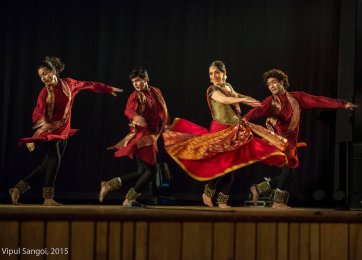 Aditi Mangaldas & group 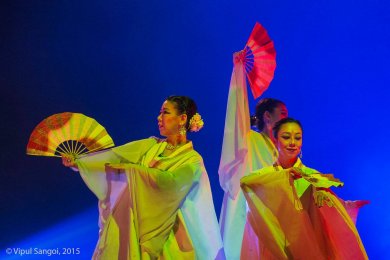 Atsuko Maeda & group The finesse of Kumiben’s choreography crystallized in Aditi Mangaldas’s ‘Unchartered Seas’. With precision of movement, light, rhythm and energy, this piece was yet another facet of how one explored the idiom. What can one say? It is not only difficult, but may be even impossible to find a good Kathak dancer of these high sophisticated standards like Aditi, anywhere across North India. And yes! This blanket statement is going to make a lot of people uncomfortable. But it is a fact that, Aditi has unknowingly set such high standards. With her group Drishtikon, she performed with an added zeal considering she was in her very own city! The musical orchestra was good. However, the singer often went off-key and this bothered everyone. Atsuko Maeda from Japan utilized movements like traditional Geishas with hand fans and explored how a synergy could be brought about. In a rather original and cute attempt, it was a sight to see the Japanese dancers try to do something different from what they learnt. 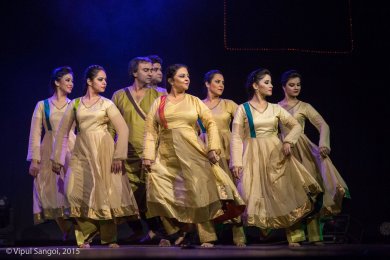 Vaishali Trivedi group 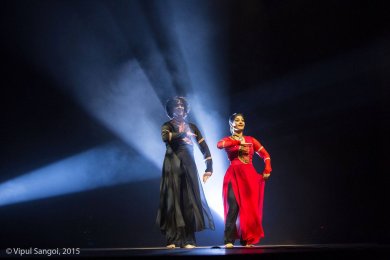 Nirupama and Rajendra On the second day, we saw many more groups of Kadamb alumni perform. In ‘Samanvay’ with twenty-one junior dancers was an exploration of balancing colours and movement in Kathak using something as simple as VIBGYOR. Once again, Kumiben’s ideas of architecturing space and movement were highlighted. Some attempts at thinking different from the usual, but sticking to the idiom of Kathak were seen in Vaishali Trivedi’s ‘Half Circle’. Set to Vivaldi’s famous Four Seasons, the piece explored a musical idea through movement. Bangalore based couple Nirupama and Rajendra presented ‘Mushti’, another old choreography of Kumiben. With some excellent music by Praveen D Rao, the piece stood out among the rest. Mingling the south Indian percussion language of Konnakol with Kathak, Praveen’s musical arrangement gave enough space for the dancers to explore the choreography well. 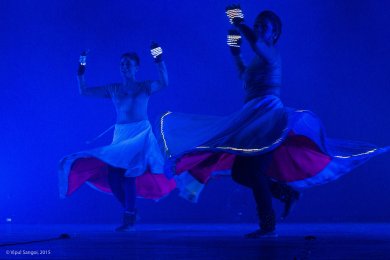 Daksha Sheth’s group However, some of the overtly contemporary work presented at the festival didn’t register the same kind of response. Daksha Sheth’s ‘Infinite’ was filled with more gimmickry than dance. Her costumes with LED lights attached played to the galleries. With vague movements in the dark, this piece didn’t convey anything. At most the piece seemed borrowed from ideas of modern dance that got dated in the 1980s in America and France. 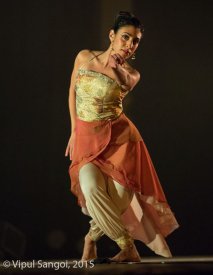 Parul Shah Parul Shah, with all the enviable flexibility in her body, lacked gravitas in her choreography. Exploring yet another abstract idea in her piece titled ‘All That’s In Between’, Parul’s movement and theme stood far apart from each other. Added to this was an absolutely out of tune singing by Isabella Castellvi. One couldn’t imagine it was the same artiste playing the cello so good. In Urja Desai Thakore’s ‘I, Within’ dealing with an abstract idea of the conflict of the self, that of the mind and heart, the choreography didn’t find any leads into the theme. On separate accounts they made more sense than when put together. On the last day, Maulik Shah and Ishira Parikh presented ‘Antar Valay’. While the concept of the production was worth investing in, it became too cluttered with too much information. Dealing with just about everything from the concept of Navarasas to movements in Kathak, it felt a bit long. With proper editing and more sensible transitions within sequences, this could be yet another good piece. 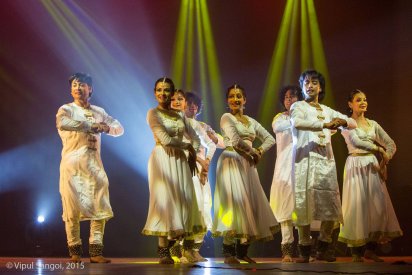 Kathak Kendra group The only disappointment of the festival was the dancers from Delhi’s Kathak Kendra. Despite choreography by Kumiben and music by Pt Madhup Mudgal, none of them could hold a stance. This reflected on the poor tutelage and how none of it seemed quality-controlled or monitored. There is better Kathak happening outside of Delhi and this festival showed the world how strong the contrast was. The festival ended with a performance by Pandit Birju Maharaj who performed to tabla accompaniment provided by the young and dynamic Yogesh Samsi.  Pt Birju Maharaj & Kumiben Over the last five decades, Kumiben has inculcated her sense of aesthetics in dance and Kadamb’s Suvarna Parva highlighted a large number of them for all of us to see and cherish. May the fragrance of her art spread across the world through her students. Wishing Kadamb many, many more decades of success! Veejay Sai is a writer, editor and a culture critic. |